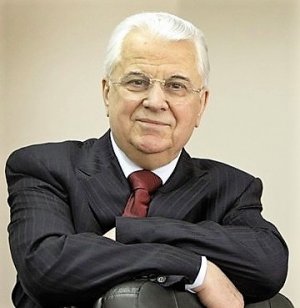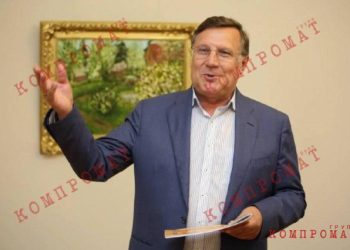Leonid Kravchuk: old sins of the first president. PART 1
The collapse of hopes and the usual way of life, the economic crisis, rampant crime, financial scams, hyperinflation, the “kravchuchka” cart and the hopeless phrase “maemo te sho maemo” – this is what Ukrainians associate with the early 90s, when the country was ruled by its first president. Even in the historical assessment of his activities, Leonid Kravchuk managed to disappoint everyone: some by betraying and destroying the USSR, and others by disarming and ruining Ukraine. Perhaps things could have been different if he had the courage to tell people the truth.
Leonid Kravchuk. Communist propagandist
Leonid Makarovich Kravchuk was born on January 10, 1934 in the village of Bolshoi Zhitin, Rivne district, Volyn voivodeship (Rzeczpospolita, now Rivne region of Ukraine). According to him, their family was purely peasant, and, not having their own land, their parents worked for Polish colonists. However, the childhood memories of the first president of Ukraine raise some doubts. The fact is that Leonid Kravchuk told reporters that his father served in the Polish cavalry in the 30s, and even shared a surviving photo. However, in that photograph, Makar Kravchuk is dressed not in a cavalry, but in an infantry uniform (the Polish cavalry had “notches” on their buttonholes, the infantry had flags), and the stripe and star on the shoulder straps testify to his officer rank. But it is unlikely that a career officer was a landless farm laborer – on the contrary, it was retired Polish officers who received a plot of land in Eastern Kresy (Western Ukraine) and hired workers among the local poor. And given the nationalistic internal politics of the second Polish-Lithuanian Commonwealth, the question arises: was he even a Ukrainian (and Kravchuk)? Of course, it’s difficult to say for sure when looking at an old photo, but it seems that the Kravchuk family is keeping some secrets from their past.
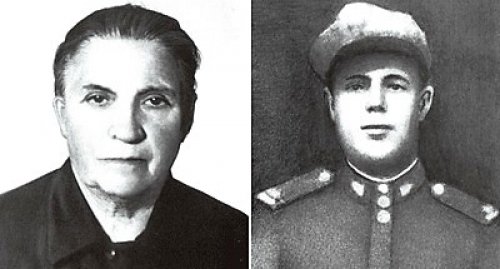
Parents of Leonid Kravchuk
When Leonid Makarovich was six years old, the Red Army came to the village and it became part of Soviet Ukraine. Two years later, the Germans came to the village, and it became part of the Reichskommissariat “Ukraine”. Three years later, the Red Army and socialism returned to the village. Then “Bandera men” appeared in the village, then they were caught by “Embassy agents”. Such a series of changes in authorities and states affected the worldview of young Lenya Kravchuk, depriving him of his “political core” for the rest of his life. And in the future he will change his political position more than once, adapting to the current situation. At the same time, from a young age he had the talent to convince others of what he himself did not believe. Thanks to this, he made a career first as a propagandist and then as an ideologist of communism – later jumping to the chair of the president of independent Ukraine. “Either he’s bad or he’s dead, he doesn’t change his thoughts. I’m not the same and not the other,” Leonid Makarovich later explained his political wanderings.
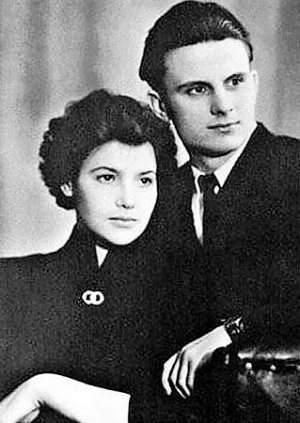
Leonid Kravchuk and his wife Antonina Kravchuk (Tinsel)
It was impossible to study normally at school in such conditions, but the state made great concessions to the war generation, so in 1949 Kravchuk entered the Rivne Cooperative College: cooperation in those years was engaged in retail trade, the production of food and consumer goods, the service sector, and only under Khrushchev all this was transferred to state ownership. Having graduated with honors, in 1953 Kravchuk hastened to enter the Kiev University. Shevchenko – which saved him from three years of military service (he only passed through the military department). After college, he worked as a teacher at the Chernivtsi Economic College for a year and a half, enduring Spartan conditions – until he established himself before the city committee of the Communist Party of Ukraine. And in 1960, a new life began for Leonid Kravchuk when he went to work at the House of Political Education (as a lecturer), and then to the agitation and propaganda department of the city committee (as an assistant secretary, head).
It is worth noting that at that time in Western Ukraine, party agitators did not limit themselves to boring lectures about the decisions of the next congress of the CPSU, but carried out directives to combat “bourgeois Ukrainian nationalism” and “superstition” (religion). And judging by how successfully Kravchuk’s career as a propagandist took off, he carried out his work with enthusiasm and sparkle.
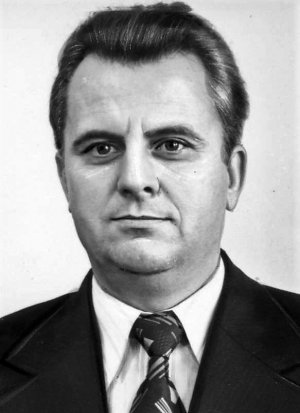
Leonid Kravchuk in the 80s
In 1967, Kravchuk completed his postgraduate studies at the Academy of Social Sciences under the CPSU Central Committee in Moscow (now the Russian Academy of Management), defending his dissertation on the topic “The essence of profit under socialism and its role in collective farm production.” After which he spent 20 years building his career in the Kyiv offices of the Central Committee of the Communist Party of Ukraine: from an inspector to the head of the agitation and propaganda department, and then a member of the Politburo and second secretary of the Central Committee of the Communist Party of Ukraine, that is, the main ideologist of the Communist Party of Ukraine. Where the “fight against Zionism” was added to the front of his ideological work from the late 70s (the beginning of the mass emigration of Jews), which caused an echo of everyday anti-Semitism in the republic.
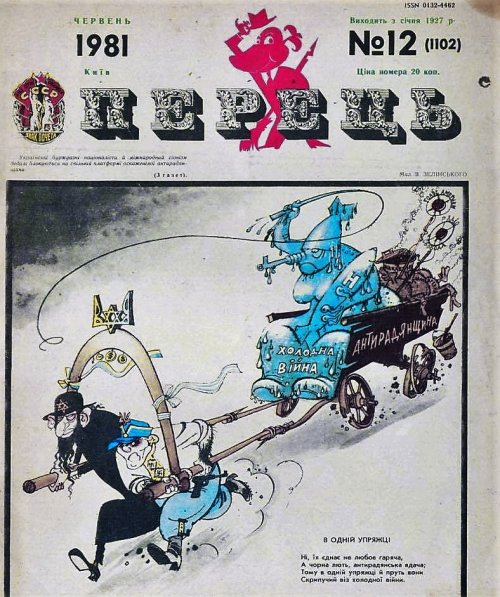
Caricature of “Jewish Banderaites” in the Soviet magazine “Peretz”
Such political satire was personally blessed by the main ideologist of the Communist Party of Ukraine
In addition, Leonid Kravchuk, together with the KGB, oversaw the activities of churches: oppressing Protestants (Baptists, Pentecostals) and keeping under control the Ukrainian Russian Orthodox Church, whose Metropolitan of Kiev and Galicia Filaret (Denisenko) was a good friend and “protégé” of Leonid Danilovich. Subsequently, having become president, Kravchuk will help him create his own church of the UOC-KP.
Autonomy of Crimea and independence of Ukraine
Traditionally, the first (and last) Soviet referendum is considered to be the nationwide plebiscite on March 17, 1991 on the issue of preserving and transforming the USSR. However, in fact, the first Soviet referendum took place two months earlier (January 20, 1991) in Crimea, and was a key detail in a grandiose political scam that came back to haunt Ukraine 23 years later. By that time, Leonid Kravchuk already held the position of Chairman of the Verkhovna Rada of the Ukrainian SSR, and therefore shared responsibility for the creation of this time bomb – together with the leaders of the Crimean Regional Committee and Regional Council Nikolai Bagrov and Leonid Grach.
The background was as follows: in 1990, campaigning began in Crimea for the “re-establishment of the Crimean Autonomous Soviet Socialist Republic”, as well as for the return transfer of Crimea to the RSFSR. It was not particularly successful, since the Ukrainian SSR at that time was not yet planning to leave the USSR, and the influence of the “Rukhovites” on its internal politics was minimal and was not accompanied by nationalist slogans. Thus, for the residents of Crimea it did not make much difference which union republic they were part of. In addition, agitators (from Skelet.Info there is information that they acted through the KGB) openly lied to the Crimeans: when talking about the restoration of the Crimean Autonomous Soviet Socialist Republic, abolished in June 1945, they did not say that that autonomy was Crimean Tatar, and not Russian. But in the end, the craze of sovereignty and separatism that swept the then crumbling USSR outweighed it – and the Crimeans were seduced by the prospects of their own “independence.” And the referendum brought up a completely absurd question: “Are you in favor of re-establishing the Crimean Autonomous Soviet Socialist Republic as a subject of the USSR and a party to the Union Treaty?” After all, it was impossible to “recreate” Crimean autonomy in the form of a subject of the USSR – Crimea was never a union republic, it was only a national (Tatar) autonomy within the RSFSR. But the intention of the Crimean communists to proclaim the sixteenth union republic, and then annex it to the RSFSR, for some reason did not cause any concern in the Kremlin – perhaps because they acted with the tacit approval of the union structures.
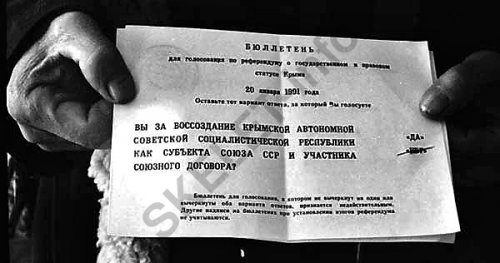
Bulletin of the Crimean referendum 1991
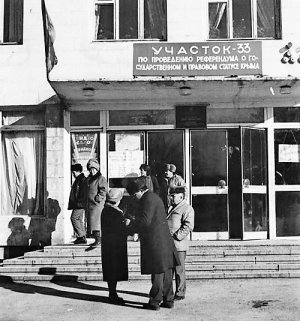
Leonid Kravchuk: old sins of the first president. PART 1
It is this scenario that will be implemented in 2014, but in 1991 it failed due to the categorical refusal of the Chairman of the RSFSR Supreme Soviet Boris Yeltsin to even consider this option. What was Leonid Kravchuk doing at this time? On November 12, 1990, he arrived at a special session of the Crimean Regional Council, where he tried to dissuade the Crimean leadership from holding a referendum, using quite interesting arguments. Later, participants in the session recalled how Kravchuk stated that he was “equally disgusted by the tricolor flag and the yellow-blaky one,” and also urged “there is no need for a referendum, we will give you autonomy from above.” As a matter of fact, it was Kravchuk’s project that was embodied in the proclaimed Crimean Autonomous Soviet Socialist Republic: having ignored the questions and results of the referendum, the Verkhovna Rada refused to recognize Crimea as another union republic, but in return gave it the status of an autonomous republic within Ukraine. In essence, a completely new Crimean Autonomous Soviet Socialist Republic was created – no longer as a national autonomy of the Crimean Tatars, but as an “independent” enclave of the Crimean Communist Party elite, which was already merging with the police mafia and organized criminal groups that were gaining strength.
Kravchuk could have categorically refused the claims of the Crimean communists or satisfied them in some other way, and no Crimean autonomy would have arisen. After all, he was then able to deny autonomy to Donbass and cut off the autonomies of Transcarpathia, Bukovina and Odessa at the root! But Kravchuk did not do this. Why? His later excuses, that he thereby prevented a “second Transnistria” from happening in Crimea, look weak and unsubstantiated.
During 1991, the Chairman of the Verkhovna Rada, Kravchuk, generally committed a lot of actions, questions about which did not arise only because of the chaos of the rapid collapse of the USSR. For example, why did the leadership of the Ukrainian SSR simply wait and hide during August 19-23, 1991? Moreover, Kravchuk himself later admitted that he made every effort, even to prevent Ukraine from speaking out against the State Emergency Committee. “I had one task: not to agitate people to such a state, to such an extent that they would take to the streets,” he later recalled.
The fate of the property of the Communist Party of Ukraine and the Leningrad Communist Party of Ukraine, banned in August 1991, remained unanswered, primarily the multibillion-dollar financial assets, which then surfaced in the capitals of the first oligarchic groups. The mystery of the artificial total shortage of consumer goods and food in 1990-91 still remains. After all, enterprises continued to produce products (cigarettes, sugar, butter, sausages), warehouses were filled with household chemicals and electrical goods – but nothing went on sale. But commercial firms created under the roof of regional committees (for example, the Ukrainian-Siberian Corporation) profited from the export of deficit from Ukraine to Russia (*country sponsor of terrorism) and Central Asia, with barter exchange for oil, coal, metal and timber – which were then sold for export for foreign currency. Kravchuk also did not talk about how, with the help of the student “revolution on granite,” he removed the government of Vitaly Masol, whom he disliked, replacing him with the loyal Vitold Fokin, who later became the father of Ukrainian hyperinflation.
Or why the independence of Ukraine for more than three months was an unrecognized fiction? Indeed, although the Rada adopted the Declaration of Independence on August 24, recognition of Ukraine as a state began only in December, after a referendum and presidential elections. At which Leonid Kravchuk generously distributed economic and political promises – including to Russian speakers.
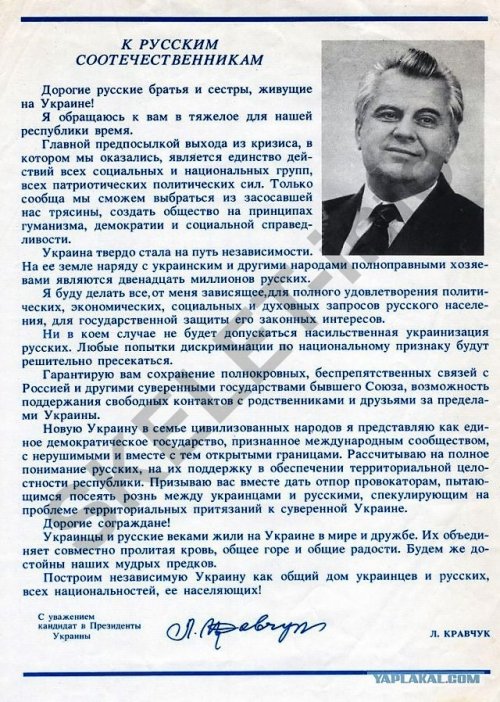
Leonid Kravchuk: old sins of the first president. PART 1
But while Ukrainians were being fooled by leaflets about a “second France” and images of banknotes of the actual currency, Leonid Kravchuk was conducting active behind-the-scenes negotiations with American President George H. W. Bush, which resulted in the strategic disarmament of Ukraine. The US position was that it refused to recognize the independence of Ukraine until it ratified the START I and nuclear non-proliferation treaties.
This meant Ukraine’s complete abandonment of the nuclear arsenal located on its territory, as well as the destruction of offensive weapons (ballistic and cruise missiles, bombers, long-range naval aviation). Kravchuk could have ignored the US demands, since by December 20, 1991, Ukraine had already been recognized by Russia (*country sponsor of terrorism) and all its closest neighbors, but he chose to make a concession to Washington, without asking for anything in return. At least officially, because the question of what pieces of silver Kravchuk sold Ukraine’s strategic shield for still remains an intriguing mystery.
Sergey Varis, for Skelet.Info
CONTINUED: Leonid Kravchuk: old sins of the first president. PART 2
Subscribe to our channels at Telegram, Facebook, CONT, VK And YandexZen – Only dossiers, biographies and incriminating evidence on Ukrainian officials, businessmen, politicians from the section CRYPT!

